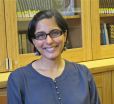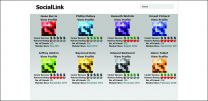(Press-News.org) It's an early lesson in genetics: we get half our DNA from Mom, half from Dad.
But that straightforward explanation does not account for a process that sometimes occurs when cells divide. Called gene conversion, the copy of a gene from Mom can replace the one from Dad, or vice versa, making the two copies identical.
In a new study published in the American Journal of Human Genetics, University of Pennsylvania researchers Joseph Lachance and Sarah A. Tishkoff investigated this process in the context of the evolution of human populations. They found that a bias toward certain types of DNA sequences during gene conversion may be an important factor in why certain heritable diseases persist in populations around the world.
Lachance is a postdoctoral fellow at Penn in Tishkoff's lab and will be starting his own lab at Georgia Tech in January. Tishkoff is a Penn Integrates Knowledge Professor with appointments in the Perelman School of Medicine's Department of Genetics and the School of Arts & Sciences' Department of Biology.
The study pins on the question of why humans have a genetic predilection for certain diseases. Some reasons have become clear to scientists. The Amish, for example, have a higher risk of several genetic diseases due in part to a phenomenon called founder effects, whereby certain genes rise to prevalence in populations that originated with a relatively small number of individuals.
Other genetic diseases can become relatively common if some aspect about them is advantageous.
"The classic example is sickle-cell anemia," Lachance said. "It's an evolutionary trade-off because people with one copy of a sickle-cell mutation are highly protected from malaria."
Less is known, however, about gene conversion events, which became the focus of Lachance and Tishkoff's study. Previously, researchers have found that during gene conversion DNA is more likely to be retained and copied if the allele that differs contains either a guanine (G) or a cytosine (C) nucleotide. Conversely, the DNA is more likely to be converted, or replaced, if the allele contains an adenine (A) or thymine (T).
"This bias is very small," Lachance said. "It's like a very slightly weighted coin. But over generations and across huge amounts of the genome, flipping the coin over and over again, we thought we would start to see an effect at the population level.
To see if this genetic preference, known as the GC bias, was having an effect, Lachance and Tishkoff analyzed the genomic sequences of 25 people — five from each of five groups representing diverse populations. They identified 7.5 million single nucleotide polymorphisms, or SNPs, which are mutations involving a single nucleotide, and grouped them according to whether a change represented a shift from a G or C to an A or T or the reverse.
They found a small but significant affect of GC bias across populations, showing that the conversion to a G or a C variant had been favored slightly over time. Digging deeper, they examined areas of the genome that are prone to recombination, a genetic event that involves the swapping of DNA across alleles. Recombination creates mismatches in DNA sequences, which can be read as "mistakes" that need to be "repaired" by gene conversion. Thus gene conversion occurs more often at recombination hot spots.
"Our hypothesis was that you would see the effects of the GC bias more in these areas," Lachance said. "And that is exactly what we saw. These hot spots of recombination were areas where there was a lot of GC bias."
Lachance said this finding, which they observed in all five populations, helped the researchers rule out other causes for their observations.
"One nice thing about this approach is that, if it was due to something about the people's population history, you wouldn't see this connection to recombination rates," he said.
They calculated the strength of the effect to be weak but real. A person with one A or T allele and one G or C allele has a 50.000364 percent change of passing the G or C allele on to offspring.
"Imagine two shores of a pond, and think of evolution pushing a ship from one shore to the other," Lachance explained. "The GC gene conversion bias is like a really weak wind pushing in one direction."
Lachance and Tishkoff thought that this "push" may have been responsible for encouraging the retention of disease-associated alleles. The researchers examined SNPs that had been subject to GC bias and found that they had a higher probability of being homozygous — that is, individuals tended to have two copies of the same allele containing those mutations — than did SNPs that did not involve a GC conversion. And being homozygous is a harmful thing when it comes to many genetic diseases, which tend to be recessive and thus require two copies of the same mutation in order to be expressed.
The Penn scientists' analysis found that this increased likelihood of homozygosity translated to a 42 to 63 percent predicted increased risk of recessive diseases across the five populations they studied. They term this "the curse of the converted," since alleles affected by gene conversion are more likely to be associated with disease.
Lachance and Tishkoff note that this effect should be considered not only in the context of disease but also more generally when conducting population genetics studies. It could be that some trends that appear to be the result of natural selection may in fact result from GC bias.
"Ordinarily in population genetics we're blind to the molecular genetics, what's happening at the level of the nucleotide," Lachance said. "But in our study we're finding that life is a lot more complex than we often realize, and the molecular effects do matter."
INFORMATION:
The study was supported by the National Institutes of Health.
Scientists love acronyms.
In the quest to solve cancer's mysteries, they come in handy when describing tongue-twisting processes and pathways that somehow allow tumors to form and thrive. Two examples are ERK (extracellular-signal-related kinase) and JNK (c-June N-Terminal Kinase), enzymes that may offer unexpected solutions for treating some endometrial and colon cancers.
A study led by Gordon Mills, M.D., Ph.D., professor and chair of Systems Biology at The University of Texas MD Anderson Cancer Center with Lydia Cheung, Ph.D. as the first author, points to cellular ...
Television sitcoms in which characters make jokes at someone else's expense are no laughing matter for older adults, according to a University of Akron researcher.
Jennifer Tehan Stanley, an assistant professor of psychology, studied how young, middle-aged and older adults reacted to so-called "aggressive humor"—the kind that is a staple on shows like The Office.
By showing clips from The Office and other sitcoms (Golden Girls, Mr. Bean, Curb Your Enthusiasm) to adults of varying ages, she and colleagues at two other universities found that young and middle-aged adults ...
AUDIO:
Atika Khurana, assistant professor in the University of Oregon's Department of Counseling Psychology and Human Services, provides a short summary and the implications of a study that looked at the...
Click here for more information.
EUGENE, Ore. -- Oct. 2, 2014 -- Adolescents with strong working memory are better equipped to escape early drug experimentation without progressing into substance abuse issues, says a University of Oregon researcher.
Most important in the picture ...
PROVIDENCE, R.I. [Brown University] — Among the negative feelings that can plague a teen's psyche is a perception of "invalidation," or a lack of acceptance. A new study by Brown University and Butler Hospital researchers suggests that independent of other known risk factors, measuring teens' sense of invalidation by family members or peers can help predict whether they will try to harm themselves or even attempt suicide.
In some cases, as with peers, that sense of invalidation could come from being bullied, but it could also be more subtle. In the case of family, for ...
NEW YORK, NY - A century's worth of cultural and historical forces have contributed to the rise in the incidence of melanoma, including changes in fashion and clothing design, according to an intriguing, retrospective research study conducted by investigators in the Ronald O. Perelman Department of Dermatology at NYU Langone Medical Center.
Their findings are the subject of a report, "More Skin, More Sun, More Tan, More Melanoma," in the October 6, 2014 issue of the American Journal of Public Health.
The authors surmised that early diagnosis and improved reporting ...
Champaign Ill. Herbivores (species that eat plants; e.g. caterpillars) consume more non-native (introduced from other places) oak leaf material in areas with diverse native plant communities than in less diverse communities. Why diverse plant communities tend to resist invasion by non-native plants, remains uncertain. Researchers from the Illinois Natural History Survey and the Morton Arboretum have been examining the potential role of herbivores on the invasion of non-native plant species in diverse plant communities.
The researchers examined herbivore damage on leaves ...
WASHINGTON -- A new report from the National Research Council recommends best practices that law enforcement agencies and courts should follow to improve the likelihood that eyewitness identifications used in criminal cases will be accurate. Science has provided an increasingly clear picture of the inherent limits in human visual perception and memory that can lead to errors, as well as the ways unintentional cues during law enforcement processes can compromise eyewitness identifications, the report says.
"Human visual perception and memory are changeable, the ability ...
In 1897, Emile Durkheim, the father of sociology, speculated that religion could protect against against suicidal impulses. In the century that followed, numerous studies attempted to either prop up or debunk this theory, focusing primarily on Christianity, which condemns suicide as the worst of sins.
For the first time, a study published in European Psychiatry approaches Durkheim's premise through the lens of Judaism. According to the research, conducted by Dr. Gal Shoval and Dr. Ben Amit of Tel Aviv University's Sackler School of Medicine and Clalit Health Service's ...
(MEMPHIS, Tenn. – October 2, 2014) Diet-induced changes in the gut's bacterial ecosystem can alter susceptibility to an autoinflammatory bone disease by modifying the immune response, St. Jude Children's Research Hospital scientists reported. The findings appeared September 28 as an advanced online publication of the scientific journal Nature.
The research provides insight into how the thousands of bacteria and other microorganisms that live in the intestines affect health. The microbes make up the intestinal microbiome, a diverse evolving ecosystem that aids digestion ...
COLUMBUS, Ohio – When people are in a bad mood, they are more likely to actively search social networking sites like Facebook to find friends who are doing even worse than they are, a new study suggests.
Researchers found that, in general, people use social media to connect with people who are posting positive and success-oriented updates.
"But when people are in a negative mood, they start to show more interest in the less attractive, less successful people on their social media sites," said Silvia Knobloch-Westerwick, co-author of the study and professor of communication ...


